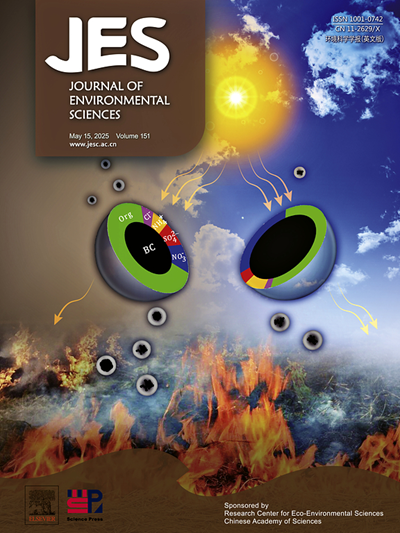Development of Palygorskite-CaIn2S4 composite for rapid Cr(VI) reduction under visible light
IF 5.9
2区 环境科学与生态学
Q1 ENVIRONMENTAL SCIENCES
引用次数: 0
Abstract
Using natural minerals to eliminate harmful Cr(VI) under sustainable sunshine has significant potential. Herein, Palygorskite nanorods were utilized as carriers for the in-situ synthesis of CaIn2S4 photocatalysts through a simple one-pot thermal process, enabling the efficient reduction of Cr(VI). With a Palygorskite to CaIn2S4 mass ratio of 5 %, the conversion rate of Cr(VI) reached 98 % after 60 min of visible-light exposure, with a remarkable reaction rate of 0.0633 min−1. The effective integration of CaIn2S4 with Palygorskite led to a more uniform dispersion of CaIn2S4, exposing more reactive sites. Moreover, the establishment of a heterojunction between CaIn2S4 and Palygorskite facilitated the transport of photogenerated electrons from CaIn2S4, enhancing the efficiency of charge separation. These factors contribute to the improved photocatalytic performance. Additionally, the developed composite photocatalysts demonstrated excellent stability under light exposure and could be reused efficiently. Trapping tests on active substances revealed that e− played key roles in the Cr(VI) reduction. This research suggests the potential of using natural minerals to fabricate composite photocatalysts capable of effectively removing pollutants from the environment using solar energy.

开发用于在可见光下快速还原六价铬的鳞片石-CaIn2S4 复合材料
利用天然矿物质在可持续日照下消除有害的Cr(VI)具有显著的潜力。本文以坡缕石纳米棒为载体,通过简单的单锅热法原位合成CaIn2S4光催化剂,实现了Cr(VI)的高效还原。在Palygorskite与CaIn2S4质量比为5%的条件下,Cr(VI)在可见光照射60 min后的转化率达到98%,反应速率为0.0633 min−1。CaIn2S4与Palygorskite的有效结合使得CaIn2S4的分散更加均匀,暴露出更多的活性位点。此外,CaIn2S4与Palygorskite之间异质结的建立促进了CaIn2S4光电子的输运,提高了电荷分离的效率。这些因素有助于提高光催化性能。此外,所制备的复合光催化剂在光照下表现出良好的稳定性,并且可以有效地重复使用。活性物质捕获试验表明,e−在Cr(VI)还原中起关键作用。这项研究表明,利用天然矿物制造复合光催化剂的潜力,能够有效地利用太阳能从环境中去除污染物。
本文章由计算机程序翻译,如有差异,请以英文原文为准。
求助全文
约1分钟内获得全文
求助全文
来源期刊

Journal of Environmental Sciences-china
环境科学-环境科学
CiteScore
13.70
自引率
0.00%
发文量
6354
审稿时长
2.6 months
期刊介绍:
The Journal of Environmental Sciences is an international journal started in 1989. The journal is devoted to publish original, peer-reviewed research papers on main aspects of environmental sciences, such as environmental chemistry, environmental biology, ecology, geosciences and environmental physics. Appropriate subjects include basic and applied research on atmospheric, terrestrial and aquatic environments, pollution control and abatement technology, conservation of natural resources, environmental health and toxicology. Announcements of international environmental science meetings and other recent information are also included.
 求助内容:
求助内容: 应助结果提醒方式:
应助结果提醒方式:


